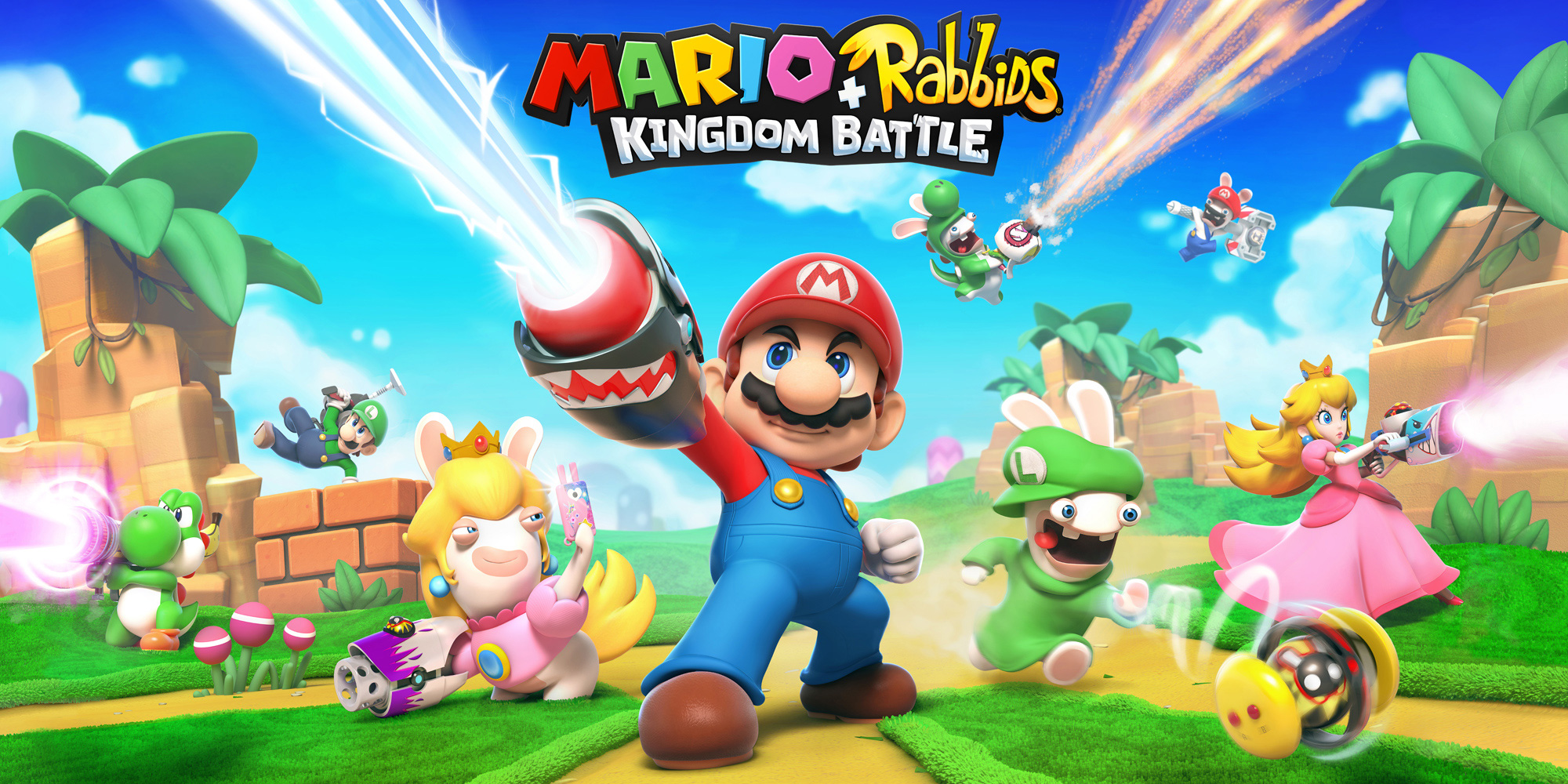When it first leaked to the world late last year, the early reception to Mario + Rabbids: Kingdom Battle mostly consisted of confusion and disdain. Ubisoft’s Raving Rabbids, despite being quite popular in their native France most notably, have had trouble finding much love in many parts of the world, and the thought of mixing them in with Nintendo’s flagship franchise definitely didn’t sit well with many people. That was before context, and explanation, and a proper announcement that kicked off Ubisoft’s press conference at this past E3. Now, Mario + Rabbids: Kingdom Battle feels like the surprisingly ingenious crossover that we didn’t know we wanted.
Not since 1996’s fan-favourite Super Mario RPG: Legend of the Seven Stars on Super NES has a major third-party game company been trusted with the Mario license, and subsequently not only come up with a final product that is just as good as many of Nintendo’s in-house Mario offerings, but also one that brings the portly plumber and his pals to a genre that they’d never previously been a part of. Mario + Rabbids: Kingdom Battle delivers the first strategy game set in the Mushroom Kingdom, being part XCOM and part modern Mario role-playing game. Offering a concept that invites deep tactics, yet is very easy to understand and work with, Mario + Rabbids is challenging, engaging and immensely rewarding throughout its surprisingly lengthy duration.
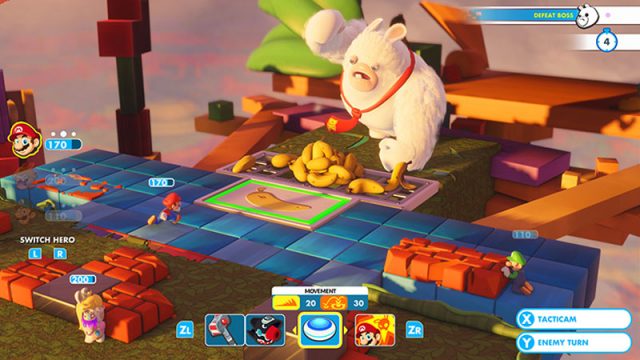
It doesn’t pull punches though! Despite its colourful, amusing exterior, Mario + Rabbids is a deceptively difficult game, and those who are less than skilled at strategy games might want to bear that in mind if they want to play it. Mario + Rabbids at least has the foresight to offer an optional Easy Mode before any battle, but even then, its A.I. is brutally uncompromising, and its combat demands very careful planning and forethought to succeed at.
If that doesn’t intimidate you however, then it remains true that Mario + Rabbids not only stands as another smash hit exclusive for Nintendo Switch, and easily the hybrid platform’s biggest and best third-party exclusive at this point (Nintendo even entrusted Ubisoft with publishing duties for Mario + Rabbids, in a very rare case for the Big N’s Mario license!), but it’s also the most interesting and memorable game that Ubisoft has produced since Child of Light back in 2014. If this is what we can expect from the Switch’s future third-party collaborations, then the upcoming game library of Nintendo’s hybrid device has a very bright future ahead of it!
Mario + Rabbids runs on Ubisoft’s relatively new Snowdrop Engine, the framework that has so far been used to power both The Division and the upcoming South Park: The Fractured But Whole. This is the engine’s first real test drive on Nintendo Switch, and the results do appear to be pretty sharp. Mario + Rabbids falls just shy of a full-fledged in-house Mario effort like the upcoming Super Mario Odyssey, but it’s still a pretty great-looking Mario game all around. Ubisoft definitely captured the feel and vibe of the Mario universe throughout Mario + Rabbids, creating a vibrant and inviting product that could easily be mistaken for one of Nintendo’s own development efforts, and that’s definitely no small feat for even a major third-party publisher/developer!
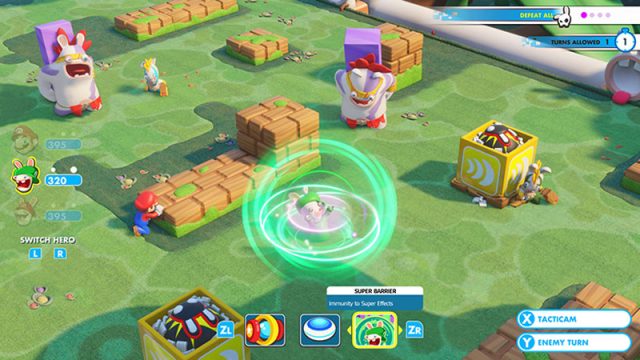
As expected, Mario + Rabbids renders at native 1080p resolution when played on a television, and downscales to 720p when played on the Switch’s handheld screen. Either way, the experience is very energetic and eye-catching, and looks smooth and lively in motion, with nary a performance hiccup in sight, regardless of whether you’re playing in Docked Mode or Handheld Mode. There’s a cartoon-ish sensibility to the diverse world environments and battles, as expected, but there’s still a sense of rewarding thrills captured by comically over-the-top Rabbid foes, as well as Mario’s allies, as they shoot it out with each other. Everything looks the part, for both franchises, and that can be very difficult to pull off with a bold, experimental crossover effort like this. Overall, Mario + Rabbids is incredibly well presented, making battles, character customization and navigation all very intuitive and engrossing, yet still realized through a very colourful and accessible style that feels perfectly true to the immensely high standards of Mario games in particular.
While Mario + Rabbids fits right in with the visual style of the Mario universe, its soundtrack is a little bit different in some respects. Ubisoft has gone for a more cheeky musical style than the normally accentuated and over-the-top joyous compositions of Nintendo’s own Mario games, which leads to a soundtrack that feels like it was pulled from a Rare game, or perhaps this year’s Kickstarter-funded platformer throwback, Yooka-Laylee. In fact, there’s no better comparison, since Grant Kirkhope, the composer behind those very games, also composes the soundtrack to Mario + Rabbids! The resulting score is something of a compromise between the light-hearted Mario soundtracks that we know and love (and yes, a few familiar Mario themes are incorporated into the soundtrack of Mario + Rabbids here and there), and the more zany, mischievous musical stylings that are often utilized in any given Raving Rabbids-themed game, yet filtered through an almost storybook style that makes the musical score nicely reflect the inevitable curiosities of the playing audience.
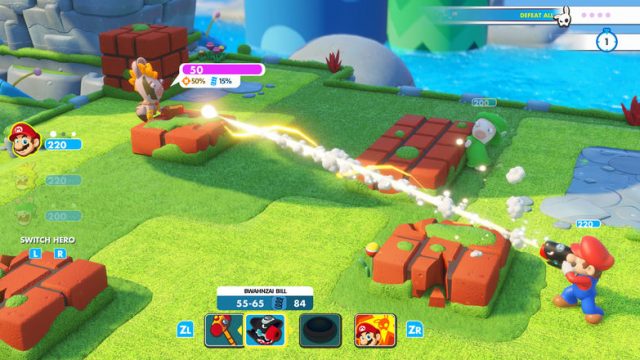
As far as the rest of the audio goes however, it’s clear that priority was given to the heavier slapstick of the Raving Rabbids franchise in Mario + Rabbids. Some familiar Mario sound effects are certainly present, such as collecting coins and going through pipes, as are authentic voice clips from regular Mario series voice actors like Mario’s and Luigi’s Charles Martinet, along with Princess Peach’s and Toad’s Samantha Kelly, but the impact behind the cartoon violence has definitely been cranked up in contrast to most other Mario games. The game’s battles still don’t really sound violent per se, but they definitely carry a greater sense of the characters inflicting exaggerated, if not discernable harm upon one another. Again though, it fits the style of the game, leading to combat that isn’t completely without a sense of elating pain, but also keeps things purely in the realm of cartoon shenanigans too.
Mario + Rabbids, like any exceptional Mario offering, is easy to learn, but significantly more challenging to master. As mentioned, the game combines the exploration sensibilities of RPG offshoots like the Paper Mario games, with a turn-based strategy foundation that most resembles genre favourite, XCOM. The core adventure of Mario + Rabbids is divided into four worlds, each consisting of eight ‘chapters’ that respectively contain a handful of TBS-style battles against opposing Rabbid forces and other such enemies. Players have to strategically position their units to fire their blasters (yes, Mario and friends are seriously packing heat in Mario + Rabbids!) during said battles, so that they can take out enemies while minimizing their own vulnerability.
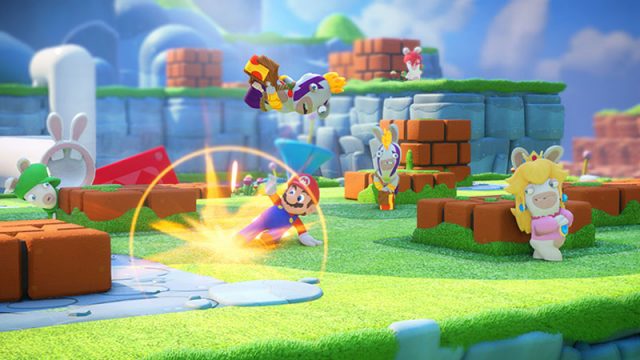
The rules of battles are quite simple on paper, since you can freely move any of your units during your side’s turn, switching between them with the L and R buttons, so long as they’re within a designated movement area. You can target and fire at any enemies in range using either a primary blaster or secondary weapon (secondary weapons are unlocked a bit later in the adventure, and can consist of things like sentry drones and grenades), but standing out in the open will quickly lead to you being decimated by your foes during the enemy turn! Ideally, you want to position your units around cover, with full cover completely protecting them from damage so long as it’s standing between your unit and the enemy’s shots, and half cover having a 50% chance of protecting units from straight blaster fire if it’s in the way. Cover can be destroyed in some instances, which is part of the strategy potential that can be exploited by both the player and the CPU, but using the indestructible natural terrain offers ideal protection, with managing the battlefield being crucial to your success in all battles in Mario + Rabbids!
It takes a bit of getting used to, but before long, the combat system of Mario + Rabbids is very easy to grasp and understand, once the novel learning curve of playing a Mario game in the strategy genre is overcome. As mentioned, you’ll have to learn fast too, since the A.I. in Mario + Rabbids does not mess around! Right from the start of the game, enemies will ruthlessly exploit any hole in your defenses, whether it’s charging through and blasting away any units in the open, taking advantage of higher ground to snipe at otherwise hidden units, or simply thinking ahead to box in your units in a bad way, leaving you few avenues to escape unharmed on subsequent turns. Again, you can take some of the pressure off by activating Easy Mode, which is done by pressing the Y Button during a battle’s introduction, but this doesn’t dumb down the punishing A.I., instead primarily giving you extra health to better survive enemy attacks.
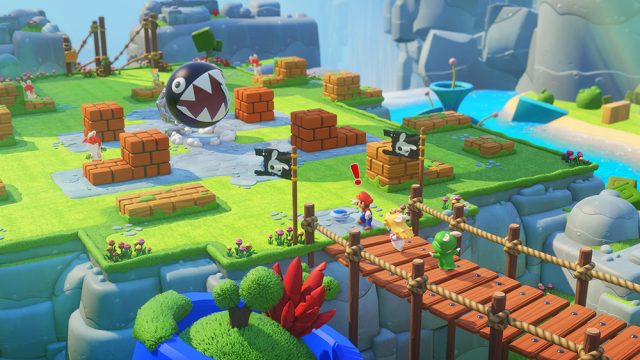
It wouldn’t be unfair to say that Mario + Rabbids throws you into the deep end right from its beginnings, and in the early game, you are quite vulnerable in many respects. Before long though, you’ll be earning coins and skill orbs for successfully completing battles, which can be spent on better weapons and new battle skills, respectively. You only have a handful of playable units in Mario + Rabbids, but this helps prevent the game from becoming overwhelming in terms of managing your party’s gear and skills, especially since you’re only allowed three player units per battle. You’ll start the game with Mario, Rabbid Peach and Rabbid Luigi, but over the course of the adventure, you’ll unlock new characters like the actual Luigi and Princess Peach, along with a Rabbid incarnation of Mario, and finally, both the original and Rabbid incarnations of Yoshi later on.
As you can imagine, each character has their own advantages in Mario + Rabbids, since they all equip different weapons, and have unique skill trees. Mario for example is a well-rounded character that can perform a variety of potential damage varieties and status benefits. That’s good, since Mario is the one unit that you have to use in every battle, and can never swap out. From there, Peach is a defense-focused character with high HP that can shield your nearby units from harm, as another example, while her Rabbid Peach counterpart instead has an emphasis on healing and keeping your characters strong. Each playable character can also be useful for wielding certain types of status effects against enemies, depending on the weapons they equip. Freezing enemies for example can prevent them from using support skills, while bouncing and pushing them can not only move your foes further away, but may also instantly eliminate them by knocking them out of bounds!
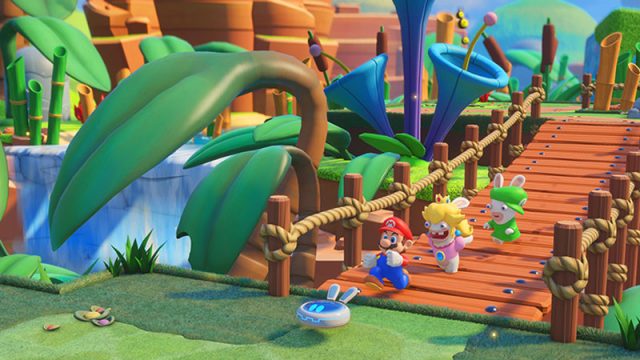
Fortunately, there’s no EXP to worry about, so your units will always be around the same power level, so long as you’re not neglecting to give them new skills and weapons. Coins are all pooled together, but each character earns their own supply of skill orbs, so it’s beneficial to keep making use of different party combinations, especially if you find that you’re struggling with a certain battle. The battles themselves are very well-designed in terms of environmental tactics and hazards, so careful strategy is often more the key to success than your actual arsenal, though the enemy Rabbid variety can be a bit wanting. Most of the game will pit you against the same Hoppers, Smashers and Supporters, offering simple quirks like being able to clear more ground, charging after units that attack them, or providing secondary skills to bolster the enemy defenses, respectively. New worlds introduce new enemy Rabbid varieties, and each boss battle is at least led by a more unique and exciting monstrosity, but the oft-repeated enemies are the one instance where Mario + Rabbids occasionally suffers by not wanting to make its fundamental strategy template too complicated.
Nonetheless, you are getting a surprisingly lengthy main adventure to enjoy in Mario + Rabbids, with the duration of the four offered worlds easily extending around 20-25 hours or more, depending on your patience and skill level. That’s before considering the game’s Season Pass and future DLC expansions as well. Before that arrives however, you do have the option of replaying battles for better rewards (if not just a few more coins), or enjoying a few extra modes, most notably the chance to take on specialized co-op ‘campaigns’ with a local friend. Disappointingly, the co-op missions aren’t playable online, but they nonetheless provide a thrilling challenge for two equally skilled strategy gaming fans who are willing to sit in the same seat, having each take control of two teams of two to try and solve puzzle-esque combat scenarios with whatever units, skills and weapons that the game’s owner has unlocked in the main adventure. Playing in co-op is as easy as each player taking a Joy-Con and passing the buck between each other during their turn as well, though you also have the option to play with a Switch Pro Controller if you so choose, as with the main single-player adventure.
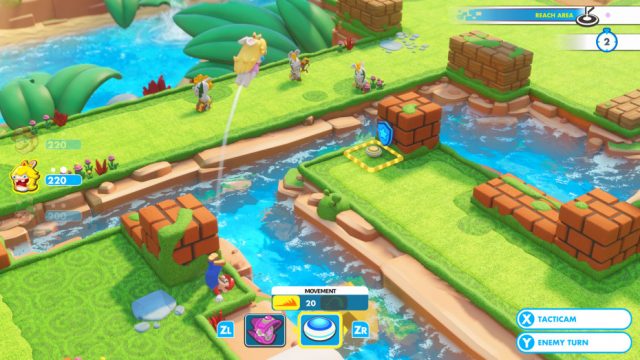
Finally, being diligent with exploration during the main adventure will also yield bonuses like 3D models, soundtrack samples and tarot cards, which can be enjoyed from the Peach’s Castle hub area, a place you can return to when you need to regroup or take a breather from where you are in the adventure’s progression. You can also scan a Mario, Luigi, Peach or Yoshi Amiibo figure from here, whether from the Super Smash Bros. set or Super Mario set, to unlock exclusive additional weapons to use for the respective characters as well, which is a small, but nice benefit if you happen to be an Amiibo collector. There isn’t too much else to do after you’ve conquered every battle and overcome every challenge in Mario + Rabbids, putting aside the upcoming DLC additions anyway, but the generous length of the main adventure, along with the surprising and engaging challenge throughout said adventure, will nonetheless keep strategy fans busy for quite a while!
Mario + Rabbids puts gameplay first, but its predictably insane storyline still provides no shortage of entertaining moments. The crossover is set into motion after the Raving Rabbids accidentally wind up in an inventor’s workshop with their time traveling washing machine, in a cute throwback to Ubisoft’s Wii party game, Raving Rabbids Travel in Time. Naturally, the Rabbids start running around, messing with the inventions and wreaking general havoc in the workshop, but after accidentally activating a ‘SupaMerge’, a device that can fuse any two things together, the Rabbids combine with the inventor’s Mario paraphernalia, which leads to their washing machine sucking them into the Mushroom Kingdom, before the possessed Rabbid wearing the SupaMerge unleashes numerous dangerous Rabbids upon the land. It’s of course up to Mario and friends to drive out the Rabbids and set things right again, and fortunately, some cosplaying Rabbids team up alongside them to ease the trip back home as well.
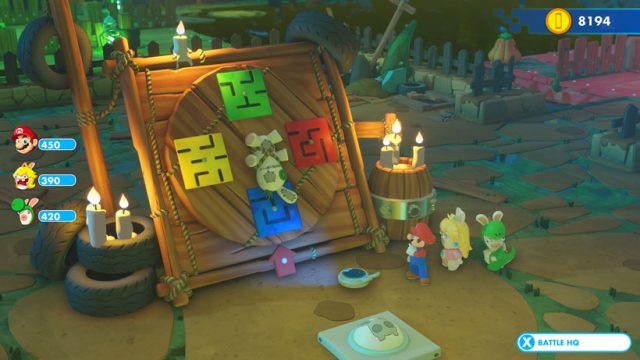
The storyline is the one place that provides liberal clues about Mario + Rabbids not actually being published by Nintendo. The humour, while still reasonably kid-friendly, is significantly more raw and irreverent than former Mario games, complete with even having comical censored cursing here and there! The added edge of the Rabbids’ humour certainly diminishes a small degree of the Mario franchise’s cute innocence, but it never goes too far. Even better however is that the slightly edgier storytelling provides a great chance to experiment with the Mario characters in new and interesting scenarios, and Mario + Rabbids does manage to pack in some great twists, especially towards the game’s climax. I certainly won’t spoil those, but I will say that both fans of the Mario franchise and the Raving Rabbids franchise alike will enjoy the storyline in Mario + Rabbids, which feels as effectively clever as it is fittingly bonkers.
Mario + Rabbids demands a fair degree of patience, since its colourful, humourous presentation masks an astonishingly ruthless supply of challenges. If you don’t mind the fact that the game doesn’t pull punches with its strategic skirmishes however, then you’ll have a lot of fun here. Mario + Rabbids may be surprisingly punishing for those who don’t have much of a pedigree in strategy gaming, but it’s not unfair, and its fundamentals and progression are at least simple enough so as to not over-complicate the experience. It may take practice, and will result in more than a few failures among even hardened strategy gamers, but the expertly designed gameplay in Mario + Rabbids nonetheless presents something very fresh and exciting for both the Mario franchise and Raving Rabbids franchise alike. Regarding Mario especially, that’s all the more impressive when you consider that Nintendo barely had any input on this crossover’s final product!
Most importantly though, the outstanding final product of Mario + Rabbids not only lays the foundation for a very promising new Nintendo Switch franchise, but also throws the door wide open for more big collaborations between the Big N and major third-party game studios on the platform. There have certainly been some similar success stories in recent years (Hyrule Warriors, Nintendo’s collaboration with Tecmo Koei, is another perfect example, especially when this October’s Fire Emblem Warriors seems primed to repeat that success), but Mario + Rabbids is perhaps the biggest and boldest trust exercise between Nintendo and another game company. Fortunately, Ubisoft has done amazing work with Mario + Rabbids, rewarding this faith with one of the best Mario spin-offs in years, and easily the best Raving Rabbids game made to date, unseating the Wii’s rather underrated Rabbids Go Home from 2009.
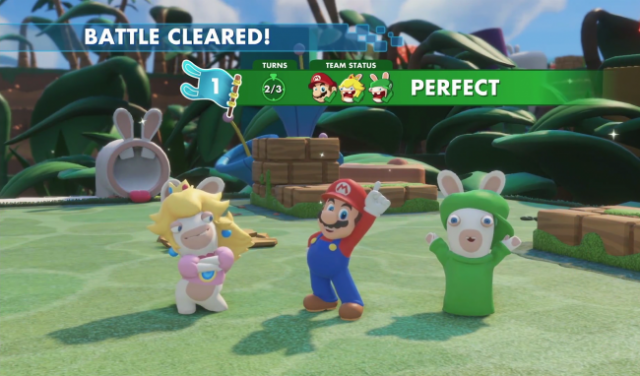
We’ve already been spoiled by several fantastic Nintendo Switch exclusives so far in 2017, but Mario + Rabbids is an especially satisfying breath of fresh air, both in terms of its creative concept, and its assurance that Nintendo is committed to working with third-party publishers and developers on future blockbuster releases for Nintendo Switch, addressing one of their recent platforms’ most frequent criticisms. If you can handle the challenge, this is one insane, yet immensely rewarding crossover, standing tall as one of 2017’s defining dark horse gaming hits!
This review is based on a copy of, “Mario + Rabbids: Kingdom Battle” provided by Ubisoft.

